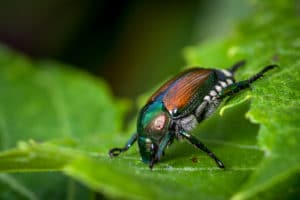
 The Japanese beetle, and Japanese beetle grubs, are a notorious landscape pest found in the eastern United States.
The Japanese beetle, and Japanese beetle grubs, are a notorious landscape pest found in the eastern United States.
First discovered in Denver back in 2006, the beetle infestation is now firmly entrenched in the Colorado landscape and seems to be spreading with each passing year.
The Japanese beetle has an insatiable appetite – quickly turning your landscapes and gardens into an eyesore. There are more than 300 plant varieties the beetles love to dine on but a few of their favorites include roses, lindens, small maple trees, fruit trees, and Virginia creeper.
Eradicating this shiny green insect from your property is no easy task and treating for them could in fact endanger other more beneficial insects in your landscape.
Emily Stine, Doctor of Plant Health Horticulture at Denver Botanic Gardens says, “Unfortunately, it’s challenging to use insecticides to manage this insect because these insects feed on flowers near pollinators. Spraying insecticides may have more impact on the pollinators and other beneficial insects than the beetles. The most effective method is to collect the insects off the plants and either crush them or drop them in soapy water.”
But there are some treatments that have proven to be effective on the Japanese beetle population, while limiting the dangerous exposure to pollinators.
Ornamental Plants
Soil injections are available for American elm, birch, linden, maple, and roses. Soil injections offer longer lasting control, while greatly reducing the amount of toxins in the air. Currently, no applications are available for fruit bearing plants.
Turf
One application of granular slow release insecticide will provide yearlong control of Japanese beetle grubs in the lawn. The application should be made in June just prior to egg laying. Once the damage is evident, complete control of grubs is not possible and the damage will continue. Curative treatment is available in the fall to ensure a strong, healthy landscape come the spring.
If you suspect the shiny green beetle has infiltrated your landscape or garden, give SavATree a call today.